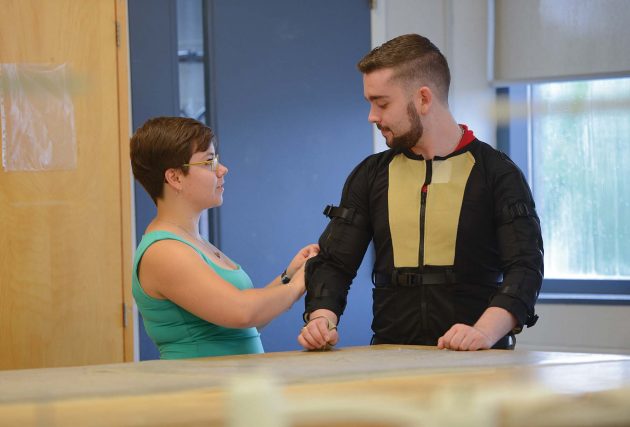
Parkinson’s innovation: Fanshawe and MDDT collaborate on a tremor suit
By PLANT Staff
Industry Innovation & Technology Manufacturing Fanshawe College Innovation manufacturingRecent college graduate Louise Marchand has designed a device that improves the accuracy of reporting and assessing Parkinson's tremors.

Fanshawe graduate Louise Marchand checking out the tremor suit. PHOTO: FANSHAWE COLLEGE
In the spirit of collaborative innovation, Fanshawe College and researchers at Movement Disorder Diagnostic Technologies Inc. (MDDT) are developing a tool that will aid people living with Parkinson’s disease.
This progressive disease of the nervous system named after English surgeon James Parkinson (1755 to 1824) mostly affects middle-aged and elderly people who experience tremors, muscular rigidity, slowness of movements and loss of balance. More than 100,000 Canadians are dealing with the disease.
Fanshawe and medical device company MDDT, both in London, Ont., have come up with a prototype for a motion capture suit and tremor sleeve that will help with the diagnosis and monitoring of Parkinson’s patients.
The suit, designed by recent Fanshawe fashion design graduate Louise Marchand, guided by the college’s design professors, improves the accuracy of reporting and assessing tremors. Accuracy is key to determining the correct dose of Levodopa – an initial pharmacological therapy for patients with Parkinson’s.
MDDT collaborated with Fanshawe’s School of Design to create a washable and durable suit for home assessments and that can be mass-produced.
The suit incorporates software MDDT uses to capture data from sensors placed at fixed points across the body and ensures ease of use for patients with varying body types and a ranges of tremor activities.
The two-piece (top and bottom) suit’s large, easy to use zippers and belting are helpful for patients with hand tremors and the mesh underlay provides breathability. Anti-skid fabric further enhances accuracy reading tremors by tightening the sensor pockets against the body.
A prototype of the TremorTek sleeve is based on an earlier design by MDDT, which commercializes technologies developed by researchers at The University of Western Ontario’s Movement Disorders Centre in London.
Tremor disorders
The non-invasive, experimental device would be used for Parkinson’s and other tremor disorders. Its multiple sensors analyze complex movements with accute accuracy. Using the data from the sleeve, doctors will isolate specific areas of the arm muscle to guide drug treatments, reducing tremors over the course of seven to 10 days.
Practitioners and caregivers would use the sleeve to treat patients at the hospital or in their homes.
Dan Douglas, dean of Fanshawe’s Centre for Research and Innovation, noted the importance of the College’s collaboration with an industry partner.
“This project demonstrates the trend towards cross-sector research and innovation activities and, in this case, by the merging of fashion with technology to develop a product for the health sector,” he said. “Projects such as this have an immediate and substantial impact for industry partners and those they serve while providing valuable experiences for our student researchers.”
The project received funding from the Natural Sciences and Engineering Research Council of Canada.
